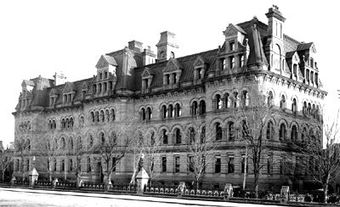The Library of Parliament came into being when the legislative libraries of Upper and Lower Canada were amalgamated in 1841 and situated in Montréal. In 1849 only 200 of the 12,000 books were saved when an angry mob protesting the Rebellion Losses Bill set fire to the Parliament Buildings. Re-established in Ottawa after completion of the original Parliament Buildings, the present library building was the only structure that survived the disastrous fire of 1916. The marvellous neo-Gothic structure was preserved in the new Parliament Buildings.
The Library of Parliament's large collection of books, documents, CD-ROMs and databases is carefully chosen to meet the demands of its parliamentary clientele. Through an integrated library system, parliamentarians have access to the automated catalogue from their offices, and the reference librarians can also search and provide information from numerous outside electronic databases. The Parliamentary Research Branch (PRB) provides substantial assistance to members of the Senate and House of Commons as well as to parliamentary committees through its subject matter specialists, including lawyers, economists, scientists, sociologists and public policy specialists. In addition to its role within government, the library also plays a public outreach role by providing information about Canada's Parliament to Canadians. The library's collections are available to other libraries through interlibrary loans with some restrictions. The library is considered a department for administrative purposes and comes under the control of the speakers of the Commons and the Senate. The parliamentary librarian holds the rank of deputy minister.
In 2002 a major renovation was undertaken to conserve, rehabilitate and upgrade the building. The Library of Parliament's collection and staff were temporarily relocated. Over the duration of the construction, 70 tonnes of steel were used for scaffolding, 4815 cubic metres of bedrock was removed to create a new basement space, 2075 square metres of copper roofing was installed and 147 leaded pane windows were repaired or replaced. Work was completed in the spring of 2006. While care was taken to retain the integrity and style of the Victorian structure, among the new features of the library were mechanized temperature and humidity controls to preserve the library's collection and protect the building. Consultation facilities for parliamentarians and for the public have also been enhanced. The library was nominated as one of "The Seven Wonders of Canada," receiving 7411 votes out of more than 1 million in a nationwide online survey conducted by the Canadian Broadcasting Corporation in the summer of 2007.

 Share on Facebook
Share on Facebook Share on X
Share on X Share by Email
Share by Email Share on Google Classroom
Share on Google Classroom




